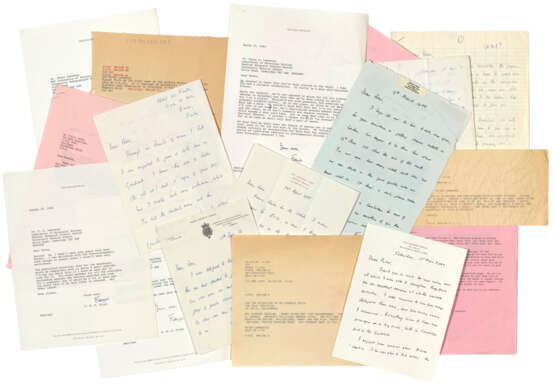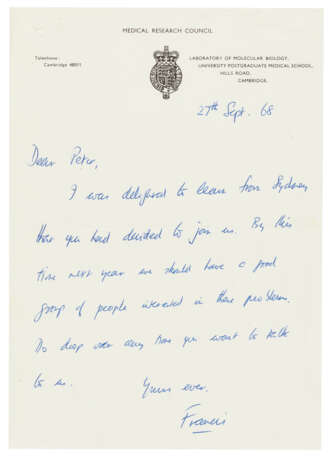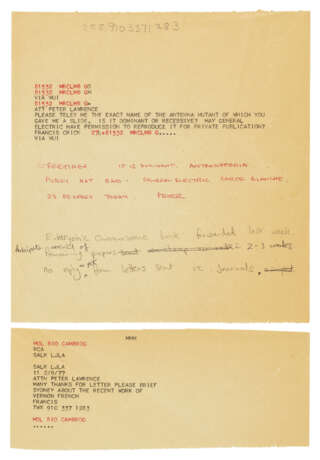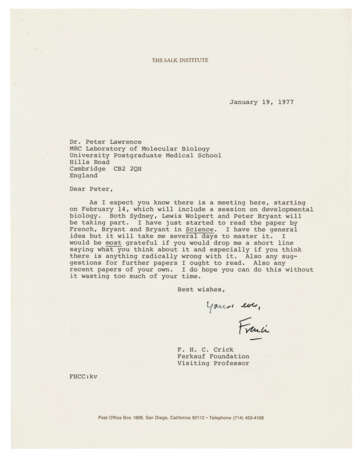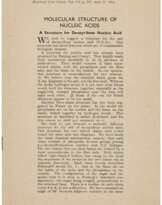ID 1249883
Lot 108 | Francis Crick (1916-2004)
Valeur estimée
£ 3 000 – 5 000
Nine autograph and 14 typed letters signed to Peter Lawrence, Cambridge, Sicily, Armenia, San Diego, Solana Beach, La Jolla and n.d., 27 September 1968 - 17 May 2003
One autograph letter in pencil, one on an aerogramme, together 18 pages, autograph, and 14½ pages, typed, the letters occasionally annotated on verso with Lawrence's draft replies, and often stapled to retained copies of Lawrence's letters to Crick, with a few telexes and faxes, and a letter from Odile Crick. Provenance: from the recipient.
On 'the origin of life on earth', chromosomes, monoclonal antibodies and neurobiololgy. The earliest letter welcomes Lawrence to the Medical Research Council: 'I was delighted to learn from Sydney [Brenner] that you had decided to join us'. Two letters in 1971 (one from 'Soviet Armenia') go into some detail on a joint paper which Crick intends to rewrite, though assuring Lawrence that 'you ... are the senior author' and he can thus object to Crick's rewriting if he wishes; in September 1971 he also mentions a new idea, 'this time about the origin of life on earth', on which he is working concurrently with 'the chromosome idea'. After his move to the Salk Institute in 1976, Crick writes on Lawrence's specialist subject of Drosophila, and asks for suggestions for papers he should read. On 7 December 1978 he asks 'HAVE YOU GONE MONOCLONAL? I do hope so. I'm convinced monoclonal antibodies will revolutionize embryology, so why not get in on the ground floor'. Later that year they discuss antennapedia and whether mutations are translocations, and in letters over the succeeding years Crick asks Lawrence's opinion on a number of papers, for example about '"feet" in insect epithelial cells. What do you make of them? Could they be the mechanism which makes certain of your grafts rotate?'. On 16 August 1982 he writes 'The postulated molecular size for the morphoges would be compatible with it being a small peptide. I'd nag you about this if I knew an easy way to look for it...'; while on 17 March 1983 he proclaims 'My thoughts are now almost entirely on neurobiology'. On 7 January 1990 he is 'So pleased to learn that there really are compartments in vertebrates. You must explain it to me'. In 1991, he mentions his support for Lawrence's candidature for the Faisal Prize, and encourages him 'Don't be nervous about your book. I'm sure it's not "stuffed" with errors'. The last letter thanks Lawrence for his notes on a conference, and mentions a dinner with Sydney [Brenner] and Leslie [Barnett], at which Brenner gave 'an amusing account of his activities'. From the 1980s onwards, the letters often ask Lawrence's recommendations and help with theatre tickets for the Cricks' visits to London, and Crick also discusses their shared pleasure in gardening.
Peter Lawrence (b. 1941) is a Cambridge-based developmental biologist and geneticist who has studied the information required to design and shape an animal, working mainly with the fruitfly Drosophila. The joint paper with Crick discussed in the letters (Lawrence, P.A., Crick, F.H.C. and Munro, M. 'A gradient of positional information in an insect, Rhodnius'. J. Cell Sci., 11, 815-853 (1972)) is a study of pattern and polarity in a sheet of cells, using a living insect, the blood sucking bug Rhodnius, as a model system; in the skin of this insect the polarity of the individual cells is expressed as oriented ripples in the surface of that cuticle secreted by the cells, and the paper considers the explanation that there is a gradient of a diffusible molecule that forms a concentration landscape, the contours of which align the polarity of the cells and thereby orient the ripples.
| Artiste: | Francis Crick (1916 - 2004) |
|---|---|
| Lieu d'origine: | Angleterre, Europe du Nord, Europe, Royaume-Uni |
| Catégorie maison de vente aux enchères: | Lettres, documents et manuscrits, Médecine et sciences, Livres et manuscrits |
| Artiste: | Francis Crick (1916 - 2004) |
|---|---|
| Lieu d'origine: | Angleterre, Europe du Nord, Europe, Royaume-Uni |
| Catégorie maison de vente aux enchères: | Lettres, documents et manuscrits, Médecine et sciences, Livres et manuscrits |
| Adresse de l'enchère |
CHRISTIE'S 8 King Street, St. James's SW1Y 6QT London Royaume-Uni | |
|---|---|---|
| Aperçu |
| |
| Téléphone | +44 (0)20 7839 9060 | |
| Commission | see on Website | |
| Conditions d'utilisation | Conditions d'utilisation |
